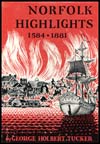Chapter 46
Lincoln Plans the Recapture of Norfolk
Abraham Lincoln never set foot in Norfolk, but he visited the area briefly in 1862 and helped plan the campaign that resulted in taking the city from the Confederate forces.
McClellan's army was in the first stages of the Peninsula campaign, and the CSS Virginia (the former USS Merrimack) and the Monitor had just locked horns on March 9, 1862, in Hampton Roads. At that point, Lincoln decided to visit Fort Monroe, "to ascertain by personal observation whether some further vigilance and vigor might not be infused into the operation of the Army and Navy."
As the presidential party, consisting of Lincoln, Secretary of State Salmon P. Chase, Secretary of War Edwin M. Stanton, and Brigadier General Egbert Ludovickus Viele left Washington on May 5, 1862, news arrived that the Confederate forces had withdrawn from Yorktown. The trip down the bay on the Coast Guard cutter Miami was rough and it was not until around nine o'clock the next night that Fort Monroe was reached.
After an early breakfast, the presidential party visited the Monitor and then went over to the Rip Raps. Just then the Virginia steamed into sight off Sewells Point, and as it was surmised that she might again engage the Monitor, the party took time off to see a fight that never took place.
That night it was decided that Norfolk must be captured in order to deprive the Virginia of her supply base. And the next morning a bombardment of the Sewells Point batteries was begun. But the sudden appearance of the Virginia put an end to the attack. It was then realized that a successful landing could only be made on the south side of Hampton Roads in a spot out of range of the Virginia's guns. And on May 9, 1862, Secretary Chase, Gen. John E. Wool, and others conducted a reconnaissance operation off Ocean View.
Returning to Fort Monroe, they found Lincoln in consultation with a pilot familiar with Norfolk area waters. The party then set out again, this time including Lincoln, who refused to permit an attack on Confederates that could easily be seen on the beach. That night, six thousand troops were ferried across to Ocean View on the Old Bay Line steamer Adelaide. No resistance was made. In the meantime, panic reigned in Norfolk where the Confederate forces, under General Benjamin Huger, were preparing to evacuate the city and burn the Gosport Navy Yard.
Lincoln, Chase, Stanton, and General Wool came over to Ocean View early the next morning but found that the troops had already begun their march toward Norfolk. Chase and Wool followed them, but Lincoln and Stanton returned to Fort Monroe to await the results. Little resistance was encountered by the troops, but upon reaching Indian Pole Bridge (now the site of the Granby Street Bridge), they found that it had been fired by the retreating Confederates and a detour had to be made.
Mayor William Wilson Lamb and other members of the Norfolk Council were awaiting them on Princess Anne Road with a flag of truce, and General Wool accepted the surrender of the city and rode back into Norfolk with Mayor Lamb and Secretary Chase in the mayor's carriage.
After Mayor Lamb had explained the surrender to a crowd at the Court House, three cheers were given for Jefferson Davis and three groans for Lincoln. Later that evening, when General Wool and Secretary Chase returned to Fort Monroe, they went straight to Lincoln's room.
"Norfolk is ours!" Wool announced. Stanton was so delighted with the news that he hugged the general. The next morning as the presidential party was about to embark on the USS Baltimore to return to Washington, Commodore Louis M. Goldsborough announced that the Virginia had been blown up by her men off Craney Island. Lincoln then visited Norfolk's inner harbor to see the still-burning Navy Yard. Anchoring off Norfolk, he and his party discovered that the Monitor and other United States vessels had preceded them.
After a brief stop at Fort Monroe, the Baltimore proceeded back to Washington. In the words of Secretary Chase, "So ended a brilliant week's campaign by the President."
Chapter
47
The Hanging of Dr. Wright
Norfolk Highlights 1584 - 1881

See the "Table of Contents" for links to every chapter in Norfolk Highlights 1584 - 1881 by George Holbert Tucker.
